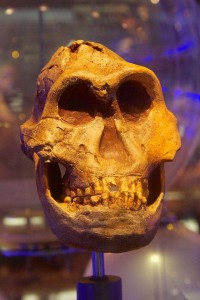Part IV: Pleistocene Epoch
19. Paranthropus robustus
Paranthropus robustus (2.3 mya)
(“beside human” / robust)

SITES
Swartkrans, Kromdraai, Drimolen, Gondolin, and Coopers Cave, South Africa
PEOPLE
Robert Broom and Andre Keyser
INTRODUCTION
In 1938, Robert Broom discovered the first Paranthropus robustus material at the site of Swartkrans, South Africa. He later found material at Kromdraai, and because the molar teeth were more primitive at that site, he changed the species name at Swartkrans to P. crassidens but used P. robustus for the Kromdraai material. Molar characteristics from the more recent material from the Drimolen site are thought to be intermediate between the Swartkrans and Kromdraai molars, and most researchers now consider the material from all three sites to be species: robustus.
PHYLOGENY
Au. africanus is the favored ancestor of P. robustus. However, others believe that P. boisei and robustus are descended from Au. aethiopicus. Of the former school, some believe that P. boisei is also descended from Au. africanus and thus a sister species to P. robustus. The two species would then have inherited their flexed skull base from Au. africanus. Like P. boisei, P. robustus appears to be an evolutionary dead end.
DISCOVERY AND GEOGRAPHIC RANGE
The species is known only from sites within the Cradle of Humankind World Heritage Site in South Africa. As mentioned in the introduction, Robert Broom discovered the first material at Swartkrans and subsequent specimens at the site of Kromdraai. Andre Keyser discovered the jaw and dental material at Drimolen in 1994.
PHYSICAL CHARACTERISTICS
Like P. boisei, P. robustus exhibited buttressing of the skull, face, and mandible; orthognathism in that the teeth were tucked under the cranial base; small anterior dentition; molarized premolars; large muscles of mastication; large zygomatic arches for passage of the temporalis muscle; sagittal crests in males and a nuchal crest that did not converge with the sagittal crest; tall mandibular rami to increase the strength of the masseter and medial pterygoid (another muscle of mastication) muscles for their tough, fibrous diet and a large mandibular body; and a high degree of postorbital constriction due to their large face (see skull cast in Figure 19.1).
Characteristics shared with Au. africanus are a flexed skull base, megadontia (P. robustus’s molars were 17% larger, but their MQ of 2.2 was lower), molarized premolars, a larger second than third molar, and facial buttressing. While P. robustus appears to have been more orthognathic than Au. africanus, they were not. Their anteriorly oriented orbits and zygomatics reduced the distance between their midface and jaws, making it appear so. The nasal bones were recessed relative to the forward-oriented zygomatics, so that they too had a somewhat dish-shaped midface like Au. africanus. They had less of a forehead than Au. africanus because of the forward-oriented orbits. Finally, unlike Au. africanus, where maximum force was on the molars, the maximum force was on the premolars due to a combination of the forward placement of the zygomatics and an enlarged anterior portion of the temporalis muscle that was offset by the positioning of the dental arcade under the braincase (Cartmill and Smith 2009).
Average cranial capacity is estimated to have been 530 cc, giving them the highest EQ, 3.0, of any australopith (Cartmill and Smith 2009).
The postcranial morphology of P. robustus shares some similarities with Homo, such as broad distal finger phalanges that are thought to indicate enlarged tactile pads and increased vascularization, sensitivity, and motor control, as well as a large attachment for the flexor pollicis longus muscle that acts as a powerful thumb flexor. They thus are thought to have had a great degree of manual dexterity and were likely capable of making and certainly using tools. However, they retained some primitive australopith characteristics, including long arms; small vertebral bodies, especially inferiorly; small sacroiliac and hip joints; more posteriorly oriented ilia; and a long femoral neck. Males of the species are thought to have stood 4′ (1.2 m) tall and weighed 120 lb (54 kg) and females, 3′2″ (<1.0 m) and 90 lb (40 kg).
Review of Primitive Characteristics
Retain prognathism, concave facial profile, long arms, small vertebral bodies, small sacroiliac joints, posteriorly-oriented ilia, and long femoral neck of Au. africanus.
Review of Derived Characteristics
- Same characteristics as P. boisei, except not as robust and large.
- Maximum bite force on premolars.
- Encephalized.
ENVIRONMENT AND WAY OF LIFE
Like P. boisei, P. robustus are thought to have been generalist herbivores that may have consumed some animal matter and could fall back on hard and brittle items, such as nuts, seeds, and hard-skinned fruits, when preferred items were not available. C. K. Brain found wooden digging sticks in association with P. robustus remains. In addition, polish on bone and horn cores (bone interior of animal horns) attributed to P. robustus is consistent with repeated digging, such as for tubers.
Of interest is recent research that indicates that they were more male- than female-philopatric, supporting the notion that we have inherited the chimp and bonobo pattern of females relocating to join and range with a group of males. Amazingly, isotopic analyses of strontium in their teeth indicates that females did not grow up where their fossils are found (Copeland et al. 2011).

